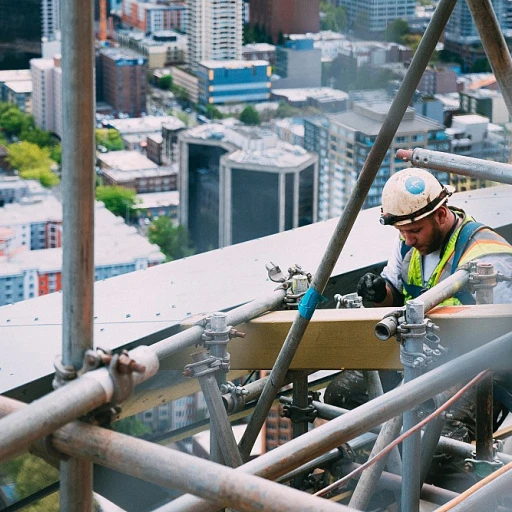Lay of the Land for Remote Performance Management
Remote work has become commonplace, transforming how managers engage with employees and evaluate their performance. At its core, remote performance management involves assessing and enhancing employee work output through various strategies and tools. This practice is vital in keeping remote teams productive, aligned, and motivated.
Remote performance management primarily focuses on maintaining effective communication and ensuring goal alignment between team members. Managers are tasked with less face-to-face interaction and more reliance on tech solutions to carry out their duties. These tools have equipped managers with the capability to conduct real-time performance reviews and check-ins seamlessly.
Another aspect is fostering employee engagement. Without regular office interactions, employees might feel disconnected. Here, consistent feedback and recognition are invaluable, bridging the gap between remote workers and their teams. Goals should be clearly defined and consistently revisited to maintain productivity and accountability.
Moreover, the best practices involve using management software that simplifies the performance management process. These tools help see employee engagement in real time, allowing for timely interventions and adjustments. Utilizing the right management tools is like finding the best GPS for a road trip; the journey becomes smooth and predictable.
Performance review cycles are yet another critical aspect. Regular reviews ensure that employees are on track to meet objectives while also addressing any hurdles they might be facing. It's not just about assessing past performance; it's about paving the way for future successes.
Forming this foundation is crucial before tackling challenges or strategizing productivity boosts. It's like knowing the rules of a game before playing, ensuring everyone is on the same page and set for growth. For more insights on how to embrace tech for remote work, check out this
game-changer.
Overcoming Communication Gaps
Remote performance management often grapples with communication barriers. The absence of face-to-face interactions can lead to misunderstandings and delays in feedback. Emphasizing open communication channels is vital. Regular check-ins using video conferencing tools can bridge this gap. Managers can gain real-time insights into employees' work performance and address issues promptly.
In the absence of water cooler chats, digital solutions like Slack or Microsoft Teams play an instrumental role in facilitating dialogue among team members. Frequent, direct interactions can foster a sense of camaraderie and ensure everyone is on the same page.
Building Trust and Accountability
Trust is another cornerstone of remote work. With everyone scattered across different locations and time zones, it's crucial for managers to establish trust and accountability. This comes from setting clear expectations and consistently following up on them.
Tracking tools, such as Trello or Asana, can help teams manage tasks effectively while keeping the process transparent. Managers should offer support and celebrate achievements, boosting employee engagement and morale. This creates an environment where remote workers feel valued and accountable.
Encouraging Work-Life Balance
The thin line between work and personal life often blurs in a remote environment. Employees might feel pressured to be always "on," impacting their productivity and engagement. Encouraging a healthy work-life balance is essential for sustained performance.
Companies can promote flexible working hours, showing trust in their team members to complete tasks efficiently without micromanagement. Additionally, it's important to remind employees to take breaks and disconnect after working hours to prevent burnout.
For an in-depth look into the available tools that can aid your remote team’s performance, check out our
blog on remote onboarding.
Making Remote Performance Management Easier
Remote work has made the need for reliable performance management systems more crucial than ever. After understanding some challenges, it's time to talk about the digital tools making all the difference.
These tools, ranging from simple applications to comprehensive software suites, help track just about everything—communication, collaboration, and, most importantly, performance. In fact, studies have shown that well-implemented management tools can lead to a 20% increase in productivity (source: Harvard Business Review). It's all about ensuring that remote employees perform their best, even when they're miles away.
The Role of Communication Software
One of the foremost contributors to remote performance management is communication tools. They bridge the gap between team members and managers, enabling real-time conversations, quick check-ins, and feedback exchanges. Think Slack, Zoom, or Microsoft Teams. These aren't just apps; they're lifelines keeping remote work alive and kicking.
Monitoring and Engagement Tools
To keep tabs on employee performance, monitoring tools like Hubstaff and ActivTrak come into play. These software solutions offer insights into how your team spends their time, helping make sure everyone's work aligns with organizational goals. With these tools, managers can offer personalized feedback based on actual data, boosting employee engagement in the process.
Engagement tools, like Officevibe, also provide valuable feedback mechanisms. Through regular surveys and feedback loops, they keep the pulse of remote teams, offering insights into what keeps them motivated and productive.
Project Management and Collaboration Tools
Imagine managing a remote team without a solid project management tool it's chaos waiting to happen. Trello, Asana, and Monday.com help sort out this mess. These platforms facilitate task allocations, deadlines, and project timelines. They allow teams to collaborate seamlessly, keeping everyone in sync and on target.
These tools have been vital in converting 'out of sight' from 'out of mind'. They've made employees feel integral to the organization, knowing their contributions are monitored, valued, and appreciated.
Technology and the Future of Remote Work
As technology advances, the array of tools catering to remote performance management will only grow. The software is already evolving to better support remote environments, adapting to what managers need to create an effective performance review process. It's a testament to how remote work is not just surviving but thriving.
With so many tools aiding productivity, it's worth exploring
cloud-based HR solutions for modern workforce management. These solutions integrate various functionalities, simplifying remote performance management.
In the ever-evolving remote work scene, it's essential to stay updated on best practices and modern tools for your team to thrive.
Strategies for Enhancing Remote Team Productivity
Building Better Communication Channels
Remote work can feel like trying to catch up with a conversation happening in a noisy café. Communication is the lifeline of any team, but with remote employees, it requires clarity and consistency to keep everyone on the same page. Managers need to foster open dialogues with employee performance being a focal point, by scheduling regular check ins. This can be a combination of formal performance reviews and informal updates. Software like Slack or Microsoft Teams, known for real-time updates, proves invaluable in this scenario.
Setting Clear and Achievable Goals
You can't manage what you don't measure. For effective performance management, you must set clear goals that are understood by the entire team. Technology comes into play here with tools like Trello or Asana that help in mapping out tasks and tracking progress. These platforms ensure that team members are aware of what is expected of them and how their work contributes to the team’s success. Frequent feedback loops help remote workers stay aligned with personal and team objectives, enhancing overall productivity.
Cultivating Employee Engagement
Remote working has its perks, but it can also lead to disengagement if not addressed. Keeping the team's morale high is a priority for any empathetic manager. Engaging team members through virtual coffee breaks, online team-building activities, or recognition platforms like Bonusly can make a noticeable difference. It’s all about letting the employees know that their efforts are appreciated and their presence is valued, fostering a collaborative spirit.
Optimizing the Use of Management Tools
Software is only as good as its implementation. Managers need to choose the best tools for their specific needs and ensure all team members are comfortably trained in their use. Whether it's project management tools or communication platforms, each should be aimed at simplifying the process and not adding layers of complexity. This means conducting regular tech audits and updates, ensuring everyone is in sync with the latest features and functionalities to boost efficiency.
In summary, the core of successful remote performance management is effective communication, clear goal setting, active engagement, and proficient use of management tools. These strategies empower both managers and remote employees to enhance work performance and keep the ball rolling effortlessly.
How Do We Track the Wins and Progress?
When it comes to evaluating remote work performance, measuring success is not just about checking tasks off a list. It's the art of understanding how remote employees are performing and contributing to the team's goals. This isn't just the domain of management or managers; it involves everyone in the team.
Tracking employee performance can start with something as simple as regular check-ins. Remote performance reviews, held at consistent intervals, can shine a light on an employee's progress and challenges. These are not just about critiquing; they should be two-way streets where feedback flows both ways, offering insights that encourage employee engagement and productivity.
Using Tools That Actually Help Us See Clearly
Software and tools play a big role in making this process clearer and more effective. From management software to collaborative communication platforms, there's a world of options out there designed to keep remote teams connected and productive. These tools not only help streamline processes but also aid in providing real-time updates, letting employees work towards clearly defined goals at their own pace.
Performance management tools gather data that managers can use to understand team dynamics, individual performance, and overall productivity. They provide insights that are essential for fine-tuning strategies and ensuring everyone's on the same page.
Feedback and Performance Reviews: Not Just Buzzwords
Performance reviews sound formal, but they don’t have to be stiff. They’re a chance to celebrate successes and identify areas for growth. It’s about connecting with team members and understanding their work performance. Trust-based communication makes all of this more effective. When you have open lines of communication, feedback becomes more than just a regular task; it’s a part of the ongoing process that keeps everyone aligned and motivated.
Given the rise of remote working, these reviews need to adapt. Employees need to know that their wins are recognized, and their challenges acknowledged. When feedback is specific, timely, and constructive, it becomes a tool for improvement rather than a checklist item.
Setting Goals that Inspire Action
The best goals are clear, achievable, and inspire team members. Goal setting in remote performance management isn’t about setting high bars just for the sake of it; it's about setting targets that drive engagement and productivity.
Effective performance means having every employee understand what's expected of them and how their work ties into the greater team objectives. This creates a sense of belonging and purpose that’s essential for fostering employee engagement in a remote setting.
By using these strategies and tools, not only are you setting your remote teams up for success, but you’re also building a foundation of trust and communication that propels overall performance management to new heights.
Future Insights for Performance Management
Thinking ahead, the performance management landscape for remote work is all about getting better at keeping remote teams in sync and firing on all cylinders. With work moving online more and more, managers, employees, and even the software we use have to adapt quickly. But what does the future look like?
We're already seeing some cool trends shaping the way managers keep tabs on employee performance. For starters, there's a huge push towards using more personalized feedback approaches made possible through enhanced digital communication tools. These tools let managers give real-time feedback to remote employees, closing the loop quickly and keeping communication flowing smoothly.
But let’s not forget the software that makes it all flow. Management software is evolving at breakneck speed, offering insights and analytics that help managers make informed decisions about team productivity and performance metrics without all the guesswork. This means less time wondering if the team is on track and more time spent actually working towards achieving their goals.
Employee engagement is also staying front and center. Everyone knows an engaged employee is a productive one, so companies are finding slick new ways to get everyone involved and connected. Whether through more regular check-ins or collaborative tools that make remote workers feel like they’re part of the action, there's no shortage of efforts being made here.
Additionally, with remote performance reviews becoming more commonplace, there's an increasing demand for tools that support this process seamlessly. This ensures that all team members, no matter where they log in from, receive fair and thorough evaluations. As performance reviews evolve, they’re focusing more on ongoing development and employee growth rather than just end-of-year reports.
Finally, as we dive into the future of remote work, the focus will likely continue on how effectively a team works together. The shift is more about finding ways to boost work performance and productivity while supporting the employees’ journey through feedback loops and agile management processes.
In wrapping up, the future of managing performance for remote teams is an exciting space with technology and strategies growing together. Staying on top of trends and adopting best practices, managers can build stronger, more successful teams no matter where they're based. Surely, it’s the best way forward.
These developments reflect how remote working is leveling up, addressing the challenges touched on earlier in our discussions. With a bit of finesse, we’re on track to navigate these changes proficiently.




